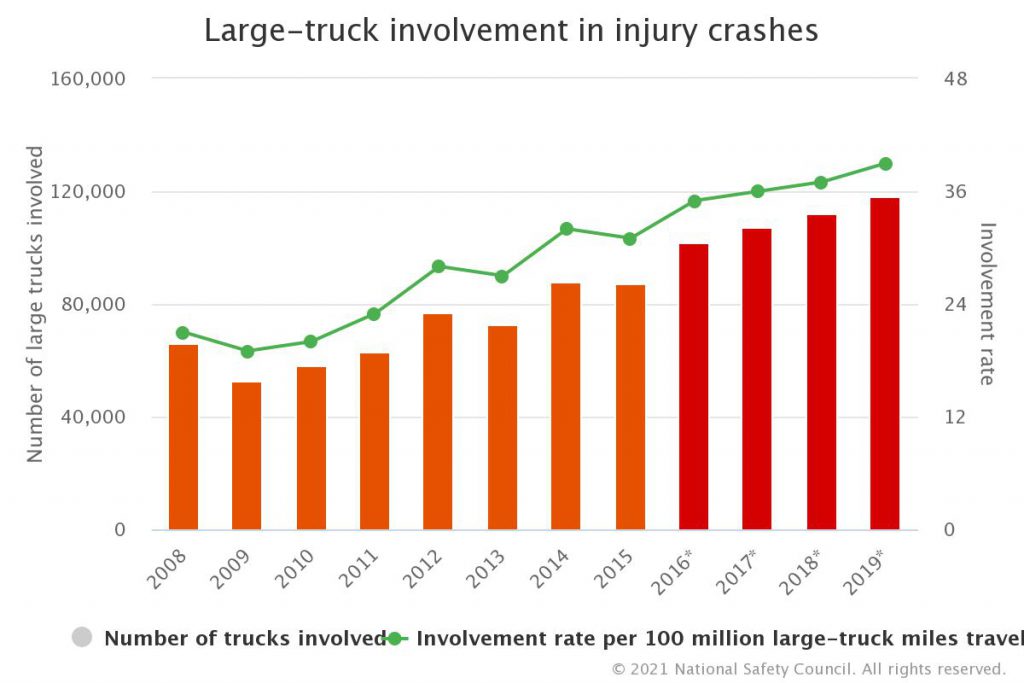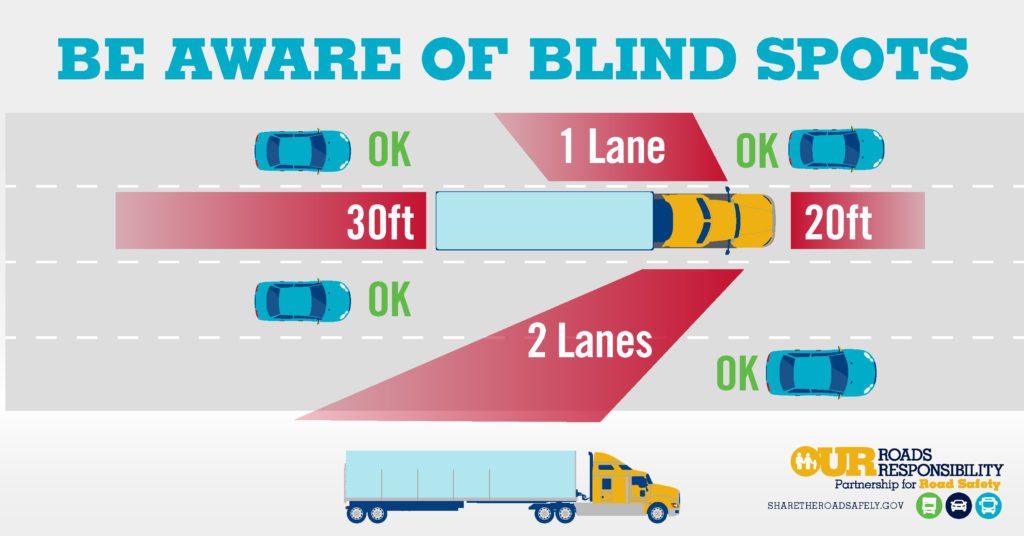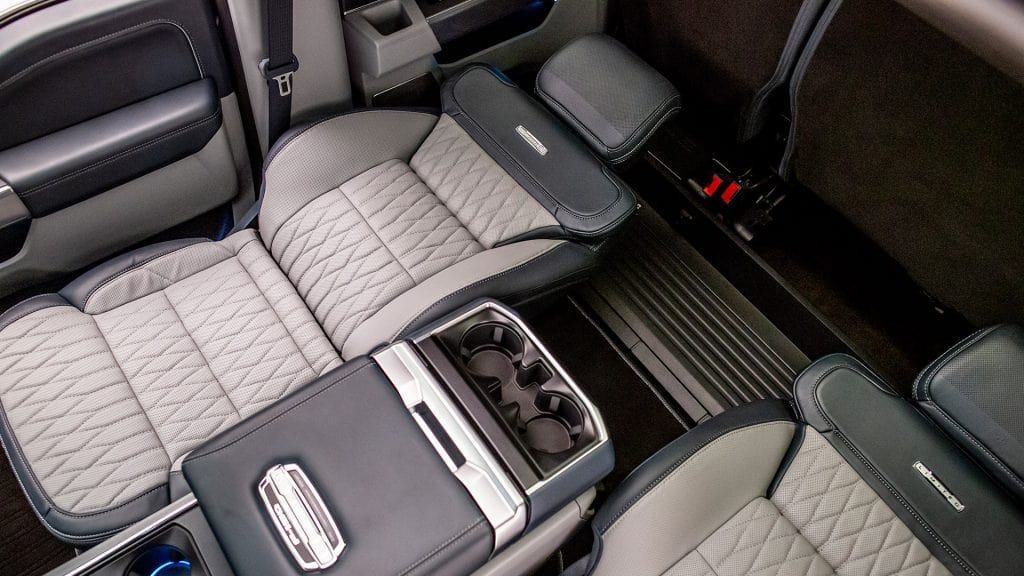10 Tips To Drive Safely Around Large Trucks
There have been so many accidents involving large trucks. Large trucks are medium or heavy trucks, excluding buses and motorhomes, with a gross vehicle weight rating greater than 10,000 pounds (4.5 tons). According to Injury Facts, in 2019, 5,005 large trucks were involved in a fatal crash, with 71% of people killed were occupants of other vehicles. This article will give 10 tips to drive safely around large trucks that you should know.

1. Avoid Blind Spots
Large trucks are, well, large, it is not easy for drivers of large trucks to observe vehicles going around them. They have blind spots that you should avoid to let them see where you are if they need to stop or take a turn.
There are four blind spots: 20 feet (6 meters) ahead, 30 feet (9 meters) behind, 1 lane on the left side, and 2 lanes on the right side. There is a rule of thumb that if you can see the driver in their side mirrors, they can see you. Be particularly careful when you want to merge, keep yourself on their vision so they can avoid hitting you.

2. Pass Safely
Before you make a passage, pay attention to vehicles around you. Especially behind you and on your left lane, it is safer for you to pass on the left because the driver can see you better (if there is a truck that wants to pass you instead, let them pass on your left too). See if any vehicles are going in the opposite direction or going to make a turn. Stay out of the blind spots, turn on the turn signals (since trucks are quite slow, you should turn on blinkers early to give the driver more time to prepare), you can use a horn to attract the driver’s attention. Then you pass, be quick for safety, and only merge when you see the truck in your rearview mirror.
You should not try to pass going down a downward slope because the truck’s speed may increase, which makes it harder and more dangerous to pass. Passing two large trucks at the same time is more dangerous and takes more time.
3. Do Not Cut Off
Cutting someone in traffic is very dangerous behavior because it puts both you and other drivers at risk, not to mention cutting off a large truck. Large trucks are 20-30 times heavier than normal vehicles and 2 times slower to completely stop. Cutting off a truck not only means you will be in their blind spots, but you also do not give the driver enough time to react and they may hit you, the heavier the truck is the harder the impact is. Even if the truck does not do it, other vehicles around you may, or you will hit someone instead. Sometimes it is unpredictable what may happen on the road, so to drive safely around large trucks, be careful.
4. Increase The Distance
It is not wise to stay too close to large trucks, especially tailgating. You should have enough distance between you and the truck’s tail for braking in case something happens. Following too close also means you are in the driver’s blind spots and you may get pushed underneath the truck, and that is an awful situation. Other cases such as the truck rolling back (especially when the vehicle is moving or stopping on a slope), tires blew out, or the things it is carrying fell out,… have happened before, many times even. You should follow behind large trucks at a 4-second distance, and a 3-second distance behind other vehicles too.
Driving parallel to large trucks at close distance is unsafe too, they may hit you when turning, or overturn on you.
5. Watch for the wide turn
Large trucks are heavy and very long, so they need to maneuver more to turn. For example, to turn right, they will swing left a little bit to get more room for the turn, or they may start turning from the middle. So pay attention to their turn signals to slow down or avoid when needed. Do not get between them and the curb, you will get hit, or in case they turn too quickly and overturn, you will be unfortunate.
More than that, do not block the box or stop in front of the lines. You will obstruct the road and accidents are more likely to happen.
6. Drive Patiently
Large trucks are slow, they are slow to speed up after stops, and they have speed limiters to control their limit. They go slow because the law requires them to ensure safety for everyone on the road. That’s why being impatient and trying to show that honking, shouting, or aggressive driving will do nothing for you nor anyone, and may potentially cause an accident while doing that. So please be patient, or you can pass them, safely, to avoid causing any inconvenience for anyone.
SEE MORE:
- 10 Most Common Causes Of Car Accidents
- Learn How You Should Behave When Driving Different Types Of Vehicles
7. Wear a seatbelt
This is obvious, you should wear a seatbelt, whether you are around large trucks or not. Wearing a seatbelt will keep you securely in your place instead of flying out of your car when an accident happens (even airbags may kill you if you are not buckled up). So take a second to wear your seatbelt and make sure everyone in your car does that too.
8. Stay focused
Staying focused is important to drive safely around large trucks. You have to pay attention to the trucks’ turn signals to give way, be aware of your surroundings (especially when it is raining or snowing), and look for an escape route should anything happen and you need to get out of the way immediately. So if you have to do something (check and send messages, make a call,…) please pull over before doing them.
9. Do not drive when fatigued or drowsy
In any case, do not drive when you are really tired and drowsy. Because in that state you are slower in reaction than normal and nod off even. 1 second of losing control may even cost your life and others’ lives. When you feel sleepy, pull over and walk around for a bit, or if you are with another driver you can ask them to switch off driving with you.
10. Do not drive when under influences
Do not drive after you drink alcohol or take medicines with side effects that make you lightheaded or sleepy. That’s dangerous, you can ask someone to drive for you instead or take transportation. Driving when you are influenced is reckless and will cause harm to yourself and others.
Conclusion
I hope this article is helpful to you and helps you drive safely around large trucks. Pay attention and follow these tips, you won’t be nervous being near large trucks anymore. To improve your driving, you can visit Driving Tips to get more useful information.














